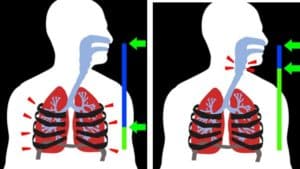Breathing is somewhat complex and, in some ways, counterintuitive. The skills needed to assess and treat breathing problems are therefore generally beyond what an officer would normally be taught or expected to understand. To do so would require additional focused training on the anatomy and physiology of the respiratory system. But in this article I’ll describe some of the critical principles of breathing.
Recent events show us the importance for law enforcement to recognize and manage breathing problems. I was a paramedic for 20 years before I became a police officer, so I cringe when I hear officers say, “If you can talk, you can breathe.” But this belief is not uncommon nor is it limited to the uninformed. Recently an officer friend of mine, who I consider to be super smart and competent asked, “He’s talking, so what’s the problem?”
Dangerous misunderstandings about breathing may include:
• A small amount of air movement or an occasional breath is enough for adequate respiration
• Being able to talk means the person is adequately breathing
And be warned: Compliance and death can look similar.
The following information should provide an enhanced understanding of how breathing works, which is vital to good police work.
How Breathing Works
Breathing involves both ventilation and respiration. Ventilation is air movement in and out of the lungs or chest. Respiration is a gas exchange. The two gases are oxygen and carbon dioxide. Ventilation and respiration work together to accomplish what commonly think of as breathing.
Ventilation
With ventilation, air moves in and out of the lungs due to pressure changes inside the chest. The two actions are inhalation or exhalation. We inhale and exhale. During inhalation the intercostal muscles, which are small muscles attached to the ribs, and the diaphragm, which is a large flat muscle, contract.
I cringe when I hear officers say, “If you can talk, you can breathe.”
The muscle contractions cause the ribs to change angle and the diaphragm to move down, which expands the chest and the lungs. The result is a decrease or negative pressure in the chest—air gets sucked in. So as the chest gets larger, it pulls the lungs along with it, stretches them out and expands them. With exhalation, all these actions are reversed in the sense that those muscles relax, the ribs return to their normal position and the diaphragm moves up. This results in the chest becoming smaller, so the pressure in the chest increases and air gets pushed out.
Respiration
Respiration involves the exchange of gases at the alveoli and the capillaries. Respiration, unlike ventilation, is a tiny process that occurs at the cellular level and involves two gases and two tiny structures. The two gases are oxygen (O2) and carbon dioxide (CO2), and the two structures are the alveoli and the capillaries.
Oxygen can be thought of as the good air or fresh air. Carbon dioxide can be thought of as waste air. The alveoli are part of the lungs and part of the air stream. Alveoli are small, thin-walled, balloon-like air sacs located at the outer portion or branches of the lungs. The capillaries are part of the bloodstream; these small, thin-walled mesh of blood vessels are located all over the body where arteries and veins transition into and from each other.
The respiratory system is trying to get oxygen to the bloodstream to be delivered to the rest of the body and get carbon dioxide to the air stream to be breathed out. Again, breathing involves both ventilation and respiration. With ventilation we move air via inhalation and exhalation; with respiration we exchange two gases, oxygen and carbon dioxide, at the site where the alveoli and the capillaries meet. Ventilation is a big mechanical process; respiration is a tiny chemical process.
Talking vs. Breathing
For talking to occur, air must move past the larynx or voice box in the throat. For respiration to occur, air must move to and from the alveoli deep in the lungs. You may have noticed that people who are short of breath can only speak in short sentences, one or two words at a time. Talking requires that air get down to the voice box, a relatively short distance, and breathing requires that air get down into the lungs.

Sometimes people state that they can’t breathe—maybe you have said this to yourself after exertion. That sensation can be the brain receiving signals that it does not have enough oxygen or there is too much carbon dioxide in the blood. In some situations, this feeling can continue because there is some unknown medical problem going on, despite an open and clear airway.
Summary
Adequate breathing requires both ventilation and respiration at the appropriate rate, depth and air quality, and allowing for good ventilation (air movement) will aid in good respiration. Additionally, we must know that talking may not necessarily equal adequate breathing. Protecting people from harm includes understanding how breathing works.
My next article will cover elements of normal and abnormal breathing, and how to recognize and respond to breathing problems.